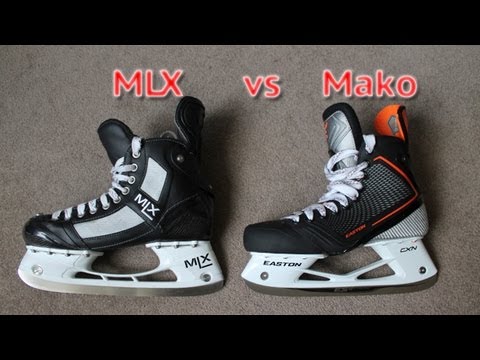The best way for me to sum up the Mako skates is to image an entirely new brand of skates. After having been an avid Easton user I can safely say the Mako skates feel nothing like anything Easton has ever produced. MLX have had an incredible impact on the production of Easton’s new line of skates.
Runner & Holder
Both of the MLX (MLX stainless blade) and Mako (ES4 stainless) skates have high quality stainless steel blades, the main difference between the two blades is the pitch. With MLX the blade pitch is positioned evenly throughout the whole skate, the blade pitch places the skate in a flat position on the ice. In regards to the Mako skate, the blade pitch is in an aggressive position, this places a bigger portion of the blade out around the heel of the skate and less of the blade position around the toe placing you in an aggressive stance on the ice all game long.
After skating on and taking a look at the MLX and Mako holders, the main difference between the two is the hight of the heel portion of the holder. The MLX holder sits a little lower to the ice than the Mako, this will contribute towards placing the skater at a much more aggressive stance on the ice giving them an advantage during quick and explosive bursts of energy on the ice.
Quarter package
The MLX quarter package is constructed with a full composite / carbon fibre shell with Kevlar inserts for increased durability. The Mako skates are constructed with a full composite quarter eliminating the need for a separate outsole as the whole quarter package is made with this rigid responsive composite material.
Tendon Guard
The MLX hybrid skate was the first hockey skate to be built with the tendon guard separately attached to the boot. This allows the skater to have a more natural style of movement on the ice (which increases the skaters range of motion). The tendon guard also allows the skater to be much more agile on the ice and corner much harder and sharper than a conventional tendon guard.
The main different between the MLX and Mako also is the new Mako skate features an asymmetrical design that is incorporated throughout the skate and tendon guard. The Mako’s tendon guard is also much smaller and more flexible.
Tongue
The Mako and MLX tongue have a lot in common, they both aren’t incredibly thick but feature well constructed metatarsal guards which prevents lace-bite. The tongue on the Mako’s does appear to be a little thicker and more well padded.
Inside liner and fit
Both of these skates feature a hydrophobically treated liner with antimicrobial properties, the liners on the Mako skate appear to be a lot more sophisticated and comfort conscious.
The fit of the Mako and MLX skates heavily rely on baking the skate to allow it to contour to the shape of each users foot, this initially makes the skates almost shapeless until they have been molded or broken in allow the boot to define itself around your foot shape. I also found that due the these thermoformable properties the skates have a slightly wider fit that previous Easton skates. Until the skates have been baked, they can seem surprisingly wide. i.e. I normally use an EE width skate, with the Mako’s I was able to use a D width which gave me a snug fitting skate. The volume of the boot is also altered once its baked as it will adapts to the shape of your own foot.
Subscribe to our Ice Hockey and Power Skating Channel












